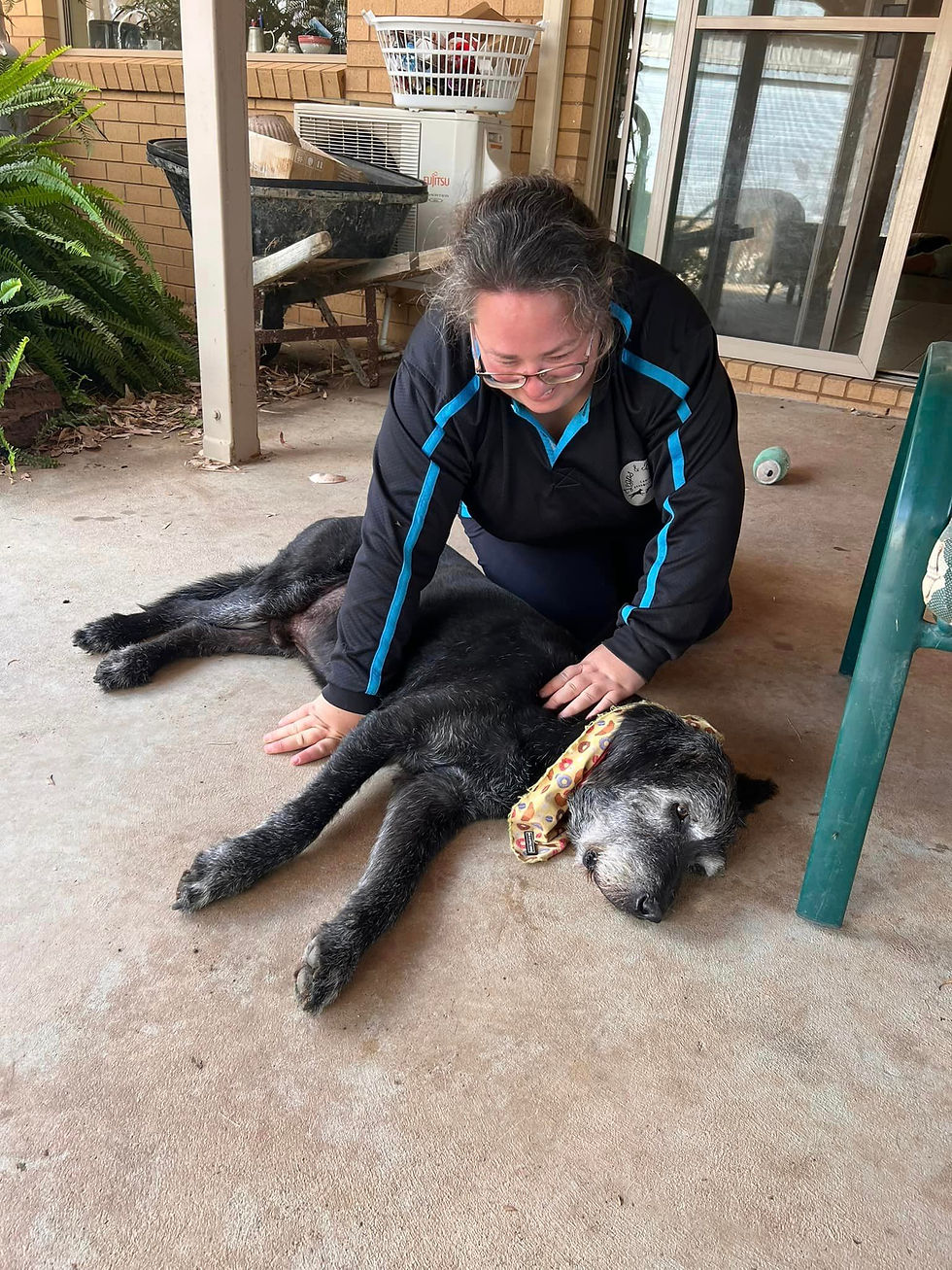Canine Remedial Massage
What is Remedial Massage?
Remedial massage is a drug-free therapy that treats the whole body, not just the injured area. It helps relieve pain and manage injuries by addressing tight muscles, "knots," and tension. The massage techniques apply pressure to muscles, tendons, ligaments, and connective tissues, promoting blood flow and releasing endorphins.
When muscles tighten up due to pain or injury, they can put pressure on nerves, causing discomfort, numbness, or limited movement. Massage helps relax muscles, improve blood flow, and restore flexibility, which reduces pain and improves movement.
Massage can also help break down scar tissue from injuries, reduce pain, and support the body's natural healing process. It helps release stuck connective tissue and improve movement. For muscles weakened by injury, disease, or lack of use, massage improves blood flow, delivering nutrients to boost muscle health and prevent further weakness.
For active dogs, massage helps improve muscle strength, flexibility, and performance. It clears out waste products and brings in fresh, oxygenated blood, speeding up recovery and reducing the risk of injury.
What to expect in your appointments
Prior to the first appointment
Dogs that have been injured or have a degenerative disease will require a Vet referral that needs to reach us at least 24 hours prior to your appointment. When booking your first appointment, please contact us so that we can arrange a referral. A referral does not require you to book an appointment – it is a form that is emailed to your vet clinic.
Assessments
At the first appointment, we will conduct an assessment prior to treatment. We also recommend regular assessments to be conducted on a regular basis to measure improvement and function. Assessments are split into three sections:
-
Subjective assessment – this is an interview where we discuss why the dog has been brought to us, what we are hoping to achieve through rehabilitation and what their daily lives look like.
-
Physical assessment – this is where we view the dog and assess their conformation and posture, we assess their body for areas of tension, any joint thickening and any muscle atrophy
-
Functional assessment – this is where we put the dog through activities to assess treatments that can assist. This includes looking at them walking and trotting, sitting, lying down, stairs etc.
The massage Appointment
In massage, we try to have the dog on the cushioned floor in a sit or lie down position. We then start by warming the muscles up through long strokes and then moving into a variety of techniques to target sore points and “knots”, release tension and reduce pain.
The aim of the treatment is to break up muscle tension, adhesions and scar tissue which can lead to a degree of discomfort during the massage – however it should never be taken to the point of pain. If the dog is experiencing distress, we can take breaks and allow the dog to move around and reset.
Post Appointment
After the appointment, we will offer some exercises that can be completed at home. We also send through a assessment report to yourself and your preferred vet clinic.
In the days following the massage session, the dog can be expected to experience some stiffness or soreness. If the pain doesn’t naturally fade away, then please contact us to talk it through.
Benefits of regular massage
Committing to regular massages is a great tool for pain management. We can focus on specific problem areas as well as tight muscles, gradually loosening them with increasing the blood circulation. These actions help to reduce pain tied to injuries, arthritis and degenerative diseases. After regular sessions, the dog may see benefits such as a reduction in the need for pain medications.
After a strain or injury to muscles and connective tissues, undergoing regular massage helps to teach a dogs body to repair themselves. This ultimately lengthens the soft tissues, allowing a greater range of motion and easier movements.
Why Massage might not be right for your dog
There are times when massage in parts of a dogs body is not recommended, however a massage session can still proceed, we would just avoid these areas. Reasons we wouldn't massage an area include:
-
Soft tissue inflammation or injury - like massaging over a bruise, we wouldnt massage on top off inflammation or injuries within the first 48 hours after an injury or surgery as this can be painful.
-
Open wounds - we would avoid massaging over an open wound
-
Bone or joint injuries / fractures - as massage is putting pressure on tissue, we will avoid massaging on any diagnosed, untreated injuries or fractures.
-
Fleas or Bacterial and Fungal Infections - to contain the spread of transferrable conditions, any condition where the skin is inflamed, red, hot, itchy or irritated we will not massage. Please contact us if you are unsure.
-
Dog is unwell - if your dog has an elevated temperature or is unwell (shock, flat or depressed, has diarrhoea etc) we will not massage. Please contact us if you are unsure.
-
Extreme distress or anxiety - We will not force a dog to have a massage and will end an appointment if the dog is showing signs of distress.
What we are trying to achieve
-
Freer movement
-
Better posture
-
Reduced stiffness
-
Increased range of movement in joints
-
Improved sporting performance
-
Relief from pain and stress
-
Improved appetite
-
Improved skin and coat
-
Ability to get in and out of a car or jump onto a couch
-
Enjoys walks again
-
Got their zest for life back







